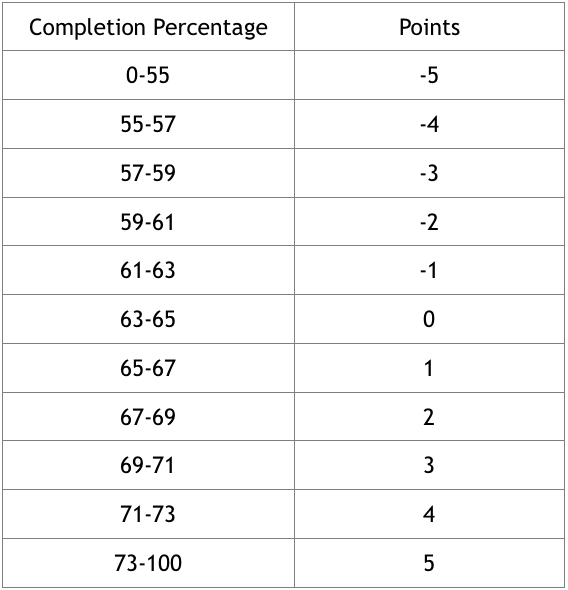Adventures in Scoring: Fixing Quarterbacks, Part Two
Hello again! Welcome back!
In case you missed the introductory piece, you can look back at it here. If you want the abridged version, here it goes:
I decided to look at quarterback scoring in one quarterback leagues, first to decide if the difference in scoring within the quarterback ranks is typical or atypical when compared to other positions. If it was atypical, I wanted to come up with a plan for potentially fixing that issue. The goal was to make which quarterback you start matter a little bit more in one quarterback leagues, hence increasing their tradability and draftability.
In part one, I mostly looked at the first question: are they truly different from the other positions? The overall conclusion was that they are. Even though a much smaller number of quarterbacks are started, the gap between good scorers and backups is extremely small. This makes acquiring a top quarterback either in trades or through the draft a pretty low priority. As a result, it creates a bit of an “all quarterbacks are the same” approach in a lot of one quarterback leagues. The only possible exception might be if you have one of the top two or three guys.
Now that we’ve identified there is an issue, the question is how do we fix it? This is where things get a little bit interesting, and where some are going to take issue with some of my choices. That is perfectly okay. There are many other options, and some of mine involve things a bit untraditional in fantasy circles, but that is part of the fun! As I mentioned in part one, I haven’t actually tried this in any of my leagues. It is merely a theory I wanted to toss out there. I tried many different scoring options, and each one was evaluated on the following criteria:
[am4show have=’g1;’ guest_error=’sub_message’ user_error=’sub_message’ ]
- Keep the scoring of top quarterbacks at roughly the same level to avoid overpowering other positions.
- Base the scoring on what makes a real NFL quarterback successful.
- Increase the gap between mid-level QB1s and QB2s, and especially between high-end QB2s and those outside the top 20 at the position.
- Must use scoring options currently available on myfantasyleague.com (MFL).
With the group rules set, it was time for the adventure to begin!
What makes an NFL quarterback successful?
This was probably the hardest part of the whole process because it was very subjective. Of course, we want our quarterbacks to throw touchdowns and pile up yardage, but what else makes a quarterback successful in the NFL? I looked at a bunch of different options, but ultimately I kept coming back to one underlying item. Successful quarterbacks in the NFL are the ones who can sustain drives. They are the ones who find a way to produce those 10-15 play drives over and over. First and foremost, they avoid turnovers. Then they find a way to get the ball out of their hands instead of taking those drive killing 8-yard sacks. Then they show good decision-making and work through their progressions to find the open receiver, even if it is just for a 4-yard check-down, to keep the ball moving.
There are lots of other qualities you want in an NFL quarterback. You want them to be the leaders of the team. You want them to have the respect of their teammates and to show up big in the most important moments. You want them to find a way to create something when everything falls apart, and you want to have hope in them even when they are down by two scores when just a few minutes are left. Unfortunately, none of these things are easily quantified, so I did the best I could do.
New Scoring System
After my conclusion that sustaining drives is the most important factor (in my opinion) of what makes an NFL quarterback successful, I had to figure out what scoring options would help. I had to throw out a few options I considered because they aren’t an option for MFL leagues currently, but ultimately I decided on the following scoring system for quarterbacks.
- All Touchdowns = 6 points
- Passing Yardage = 1 point for every 20 yards
- Rushing Yardage = 1 point for every 10 yards
- Completion Percentage = -5 up to 5, depending on percentage. 64% is 0. (See table below)
- Interceptions = -5 points
- Interceptions returned for a touchdown = Additional -5 points
- Fumbles Lost = -5 points
- Sacks = -1 point
- Yardage lost via sack = -1 point for every 10 yards
As you can imagine, this has quite the impact on quarterback scoring. Not only does it boost the positive, but it increases the negative. This is exactly what we want to separate the good NFL quarterbacks from the not so good ones. This won’t make the quarterback streamers out there very happy, but that is the way it goes!
On the positive side, I took passing touchdowns from 4 to 6 points as well as increasing the points for yardage, and added in the possibility of getting up to 5 points just for being an accurate passer. The increase in touchdown and yardage points were added in to balance out the increase in negative scoring. As you can see, the impact a turnover has on scoring has drastically increased. Sacks are also counted in scoring in addition to the potential to lose up to 5 points for being inaccurate.
All of the negative scoring items were added or increased around the central idea of what kills drives in the NFL. Turnovers clearly end a drive right then and there. Sacks have a very high correlation to ending a drive, but there is some variation based on the yardage lost. Taking a 2-yard sack is bad, but sometimes recoverable. Taking a 12-yard sack on the other hand almost certainly ends the drive.
Before I get into the exact impacts of the scoring system, let me explain the completion percentage part a little bit. I looked at the top 24 quarterbacks in the NFL, so the players who should be QB1s and QB2s in 12-team leagues. Their average completion percentage over the last few years has been right around 64 percent. I considered that the baseline, or a 0 in the scoring. At that point, I actually wanted to use a simple math formula ( 0.5 * (x-64) ) where x is the completion percentage for the game, and then put some caps on it. However, MFL isn’t set up that way. Instead, I ended up going with something broken down by ranges such as the following table:

You could always break it down a little bit more to give half points if you wanted, but the idea is the same. If a quarterback is more accurate than average, they gain a little bit. If they are less accurate, they lose a few points. The caps of +5 on the high end and -5 on the low end were added to avoid things like Cam Newton’s 39 percent competition rate one game completely killing his fantasy production or Drew Brees’ 82 percent completion rate giving him too much of a boost. I think the caps allow it to be relevant without it dominating the quarterback scoring. I should note, that in the numbers I discuss from this point forward, I used my formula to give decimal scoring for completion percentage. It gives a more detailed picture of the impact than just using an example like the table above.
What is the impact of this new scoring?
Initially, I based the effectiveness of the scoring system on the criteria listed above in relation to the week 1-16 stats from the 2017 season. One of those criteria was to not inflate the quarterback scoring at the top end. Here is a breakdown of the top five scorers in the traditional system as well as the new system.

When comparing the two groups, a few things jump out. When looking at the names, you notice Russell Wilson slides down a bit and Newton completely disappears from the top five. This is due to lower than average completion rates (Wilson had 61.3 percent and Newton was 60.5 percent), higher turnover rate than the rest of the top five (both had 14 turnovers), and a large number of sacks/yardage lost due to sack (Wilson had 43 for a loss of 322 yards while Newton had 35 for a loss of 285 yards).
Meanwhile, Alex Smith and Brees both saw significant gains for the opposite reasons. They were both above average on completion rates (Smith had 67.5 and Brees had a record 72 percent), few turnovers (Smith had 6 on the season while Brees had 8), and while Smith was slightly above average when it came to sacks (35 sacks for 215 yards) Brees was a master at avoiding them and minimizing their impact (20 sacks for 168 yards). Looking at just the scores, the top ends at roughly the same place, but the top score did increase a little bit. In the grand scheme of things, this helps to spread out the quarterback ranks a little bit, and the slight increase (about 1 point per game on average) at the top end was small enough that I was okay with it.
What about the impact outside of the top five? In the first part, I used a few different characteristics to compare quarterbacks to other positions. Let’s revisit those in the traditional system and compare them to what they would be in the new system. These are in points per game.

As I mentioned previously, this new system did slightly increase scoring at the top end. The average of the top 10 quarterbacks did go up by a very small amount, but you can also see the gap from the top of this group to the bottom did increase. More importantly, you can see the difference between the QB1 grouping and the QB2 grouping drastically increased, both in the middle and especially on the extremes of those groups. The difference between a mid-level QB1 and a high-end QB2 has now tripled from the traditional scoring system, and the gap from an elite quarterback to the QBs people might have streamed has also increased.
Overall, I think the new system definitely accomplishes the desired impacts on a season-long scale. It increased the gap between not just the elite and non-elite options but also the high quality but not elite options (like Ben Roethlisberger) and those who aren’t quite at that level (like Blake Bortles). Not only would this put more of an emphasis on acquiring a top-flight quarterback in a trade or a draft, but it would reward those who have invested in the position.
Before I can declare the new scoring system something I would completely recommend or implement into any of my own leagues, I wanted to take some time to investigate the impacts this would have on weekly scoring. My original guess was that it would add a lot of variability to the position, letting quarterbacks reach the heights some of the other positions can reach as well as making very low or even negative scores a possibility for terrible performances. That is what part three is all about!
[/am4show]
- Final 2021 Pre-Draft Rookie Mock: Round Three - April 28, 2021
- Final 2021 Pre-Draft Rookie Mock: Round Two - April 26, 2021
- Final 2021 Pre-Draft Rookie Mock: Round One - April 25, 2021


































































